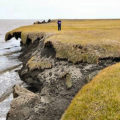
Yale University geologists have uncovered evidence that the Gondwana supercontinent underwent a rapid 60-degree rotation across the Earth’s surface during the Early Cambrian period, a crucial time in Earth’s evolutionary history when most of the major groups of complex animals appeared.
The new study, appearing in the journal Geology, is based on an analysis of the paleomagnetic record of the Amadeus Basin in central Australia, which was part of the Gondwana precursor supercontinent. Based on the directions of the ancient rock’s magnetization, they discovered that the entire Gondwana landmass underwent a rapid 60-degree rotational shift, with some regions attaining a speed of at least 16 cm/year, about 525 million years ago. By comparison, the fastest shifts we see today are at speeds of about 4 cm/year.
“This was the first large-scale rotation that Gondwana underwent after forming,” said Yale’s Ross Mitchell, author of the study. “The shift could either be the result of plate tectonics [the individual motion of continental plates with respect to one another] or ‘true polar wander,’ in which the Earth’s solid land mass [down to the liquid outer core almost 3,000 km deep] rotates together with respect to the planet’s rotational axis, changing the location of the geographic poles.”
Whatever the cause, the massive shift had some major consequences. As a result of the rotation, the area that is now Brazil would have rapidly moved from close to the southern pole toward the tropics. Such large movements of landmass would have affected environmental factors such as carbon concentrations and ocean levels.
“There were dramatic environmental changes taking place during the Early Cambrian, right at the same time as Gondwana was undergoing this massive shift,” Mitchell says. “Apart from our understanding of plate tectonics and true polar wander, this could have had huge implications for the Cambrian explosion of animal life at that time.”
Related:
Smoking Gun For Permian-Triassic Extinction Found
Equatorial Water Provided Means Of Survival During Ice Age
Ancient glaciation period yields clues to carbon cycle anomalies


















Comments are closed.